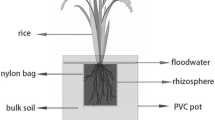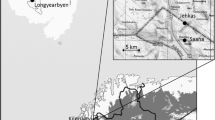Abstract
The plant rhizosphere is a dynamic environment in which many parameters may influence the population structure, diversity and activity of the microbial community. Two important factors determining the structure of microbial community present in the vicinity of plant roots are plant species and soil type. In the present study we assessed the structure of microbial communities in response to four plant species (i.e. maize (Zea mays L.), oat (Avena sativa L.), barley (Hordeum vulgare L.) and commercial grass mix) planted in soil with different land use history (i.e. arable land under crop rotation, maize monoculture and permanent grassland). Both factors, plant species and land use history, showed clear effects on microbial community and diversity as determined by PCR-DGGE fingerprinting with universal and group-specific bacterial primers. Moreover, we explored the rhizosphere effect of these plant species on the abundance of bacterial antagonists of the potato pathogen Rhizoctonia solani AG3. The data showed that the abundance and taxonomic composition of antagonists differed clearly between the different plants. The highest percentages of antagonists were found in maize and grass rhizosphere. When antagonistic Pseudomonas populations were compared, the highest, abundance and diversity of antagonists were detected in barley and oat rhizospheres, as compared to maize and grass rhizosphere. The results obtained in our study demonstrate clearly that plant species and soil type are two important factors affecting the structure of total bacterial, Pseudomonas and Bacillus community.






Similar content being viewed by others
References
Berg G, Fritze A, Roskot N, Smalla K (2001) Evaluation of potential biocontrol rhizobacteria from different host plant of Verticillium dahliae Kleb. J Appl Microbiol 156:75–82
Berg G, Roskot N, Steidle A, Eberl L, Zock A, Smalla K (2002) Plant-dependent genotypic and phenotypic diversity of antagonistic rhizobacteria isolated from different Verticillium host plants. Appl Environ Microbiol 68:3328–3338
Berg G, Opelt K, Zachow CH, Lottmann J, Gotz M, Costa R, Smalla K (2006) The rhizosphere effect on bacteria antagonistic toward the pathogenic fungus Verticillium differs depending on plant species and site. FEMS Microbiol Ecol 56:250–261
Boon N, Windt W, Verstraete W, Top EM (2001) Evaluation of nested PCR-DGGE (denaturing gradient gel electrophoresis) with group-specific 16S rRNA primers for the analysis of bacterial communities from different wastewater treatment plants. FEMS Microbiol Ecol 39:101–112
Da Silva KRA, Salles JF, Seldin L, van Elsas JD (2003) Application of novel Paenibacillus-specific PCR-DGGE method and sequence analysis to assess the diversity of Paenibacillus spp. in maize rhizosphere. J Microbiol Methods 54:213–231
Duineveld BM, Van Veen JA (1999) The number of bacteria in the rhizosphere during plant development: relating colony-forming units to different reference units. Biol Fertil Soils 28:285–291
Duineveld BM, Rosado AS, van Elsas JD, van Veen JA (1998) Analysis of the dynamics of bacterial communities in the rhizosphere of the chrysanthemum via denaturing gradient gel electrophoresis and substrate utilization patters. Appl Environ Microbiol 64:4950–4957
Duineveld BM, Kowalchuk GA, Keijzer A, van Elsas JD, van Veen JA (2001) Analysis of bacterial communities in the rhizopshere of the chrysanthemum via denaturing gradient gel electrophoresis of PCR-amplified 16S rRNA as well as DNA fragments coding for 16S rRNA. Appl Environ Microbiol 67:172–178
Felske A, Akkermans ADL, de Vos WM (1998) In situ detection of an uncultured predominant Bacillus in Dutch grassland soils. Appl Environ Microbiol 64:4588–4590
Garbeva P, VanVeen JA, van Elsas JD (2003) Predominant Bacillus spp. in agricultural soil under different management regimes detected via PCR-DGGE. Microb Ecol 45:302–316
Garbeva P, VanVeen JA, van Elsas JD (2004a) Assessment of the diversity and antagonism towards Rhizoctonia solani AG3, of Pseudomonas species in soil from different agricultural regimes. FEMS Microbiol Ecol 47:51–64
Garbeva P, van Veen JA, van Elsas JD (2004b) Microbial diversity in soil: selection of microbial populations by plant and soil type and implication on disease suppressiveness. Annu Rev Phytopathol 42:243–270
Garbeva P, Postma J, van Veen JA, van Elsas JD (2006) Effect of above-ground plant species on soil microbial community structure and its impact on suppression of Rhizoctonia solani AG3 8:233–246
Gould WD, Hegedorn C, Bardinelli TR, Zablotowicz RM (1985) New selective media for enumeration and recovery of fluorescent pseudomonades from various habitats. Appl Environ Microbiol 49:28–32
Grayston SJ, Wang S, Campbell CD, Edwards AC (1998) Selective influence on plant species on microbial diversity in the rhizosphere. Soil Biol Biochem 30:369–378
Griffiths BS, Ritz K, Glover LA (1996) Broad-scale approaches to the determination of soil microbial community structure: application of the community DNA hybridization technique. Microb Ecol 31:269–280
Heuer H, Krsek M, Baker P, Smalla K, Wellington EMH (1997) Analysis of actinomycete communities by specific amplification of genes encoding 16S rRNA and gel-electrophoretic separation in denaturing gradients. Appl Environ Microbiol 63:3233–3241
Heuer H, Kroppenstedt RM, Lottmann J, Berg G, Smalla K (2002) Effects of T4 Lysozyme Release from Transgenic Potato Roots on Bacterial Rhizosphere Communities Are Negligible Relative to Natural Factors. Appl Environ Microbiol 68:1325–1335
Keel C, Weller DM, Natsch A, Defago G, Cook RJ, Thomashow LS (1996) Conservation of the 2,4-diacetylphloroglucinol biosynthesis locus among fluorescent Pseudomonas strains from diverse geographic locations. Appl Environ Microbiol 62:552–563
Kowalchuk GA, Buma DS, de Boer W, Klinkhamer PGL, van Veen JA (2002) Effects of above-ground plant species composition and diversity on the soil-borne microorganisms. Antonie van Leeuwenhoek 81:509–520
Latour X, Corberand T, Laguerre G, Allard F, Lemanceau P (1996) The composition of fluorescent Pseudomonas population associated with roots is influenced by plant and soil type. Appl Environ Microbiol 62:2449–2456
Liljeroth E, Burgers SLGE, van Veen JA (1991) Changes in bacterial populations along roots of wheat (Triticum aestivum L.) seedlings. Biol Fertility Soil 10:276–280
Lupwayi NZ, Rice WA, Clayton GW (1998) Soil microbial diversity and community structure under wheat as influenced by tillage and crop rotation. Soil Biol Biochem 30:1733–1741
Mahaffee WF, Klopper JW (1997) Bacterial communities of the rhizosphere and endorhiza associated with field-grown cucumber plants inoculated with plant growth-promoting rhizobacterium or its genetically modified derivative. Can J Microbiol 43:344–353
Mazzola M, Gu Y-H (2002) Wheat genotype-specific induction of soil microbial communities suppressive to Rhizoctonia solani AG3 and AG8. Phytoathology 92:1300–1307
Miller HJ, Liljeroth E, Henken G, van Veen JA (1990) Fluctuations in the fluorescent pseudomonads and actinomycete population of rhizopshere and rhizoplane during the growth of spring wheat. Can J Microbiol 36:254–258
Picard C, De Cello F, Ventura M, Fani R, Guckert A (2000) Frequency and biodiversity of 2,4-diacetylphloroglucinol producing bacteria isolated from the maize rhizosphere at different stages of plant growth. Appl Environ Microbiol 66:948–955
Salles JF (2005) Burkholderia community structure in soils under different agricultural management. PhD Thesis, Leiden, The Netherlands
Salles JF, De Souza FA, Van Elsas JD (2002) Molecular method to assess the diversity of Burkholderia species in environmental samples. Appl Environ Microbiol 68:1595–1603
Salles JF, Van Elsas JD, Van Veen JA (2004) Multivariate analyses of Burkholderia species in soil: effect of crop and land use history. Appl Environ Microbiol 70:4012–4020
Sambrook J, Fritsch EF, Maniatis T (1998) Molecular cloning: A Laboratory manual, 2nd edn. Cold Spring Harbor Laboratory, Cold Spring Harbor NY.
Smalla K, Wieland G, Buchner A, Zock A, Parzy J, Kaiser S, Roskot N, Heuer H, Berg G (2001) Bulk and rhizosphere soil bacterial communities studied by denaturing gradient gel electrophoresis: plant-dependent enrichment and seasonal shifts revealed. Appl Environ Microbiol 67:4742–4751
Van Elsas JD, Garbeva P, Salles J (2002) Effects of agricultural measures on the microbial diversity of soil as related to suppression of soil-borne plant pathogens. 13:29–40
van Veen JA, van Overbeek LS, van Elsas JD (1997) Fate and activity of microorganisms introduced into soil. Microbiol Mol Biol Rev 61:121–135
Wieland G, Neumann R, Backhaus H (2001) Variation of microbial communities in soil, rhizosphre and rhizoplanin response to crop species, soil type and crop development. Appl Environ. Microbiol 67:5849–5854
Yang C-H, Crowley DE (2000) Rhizosphere microbial community structure in relation to root location and plant iron nutritional status. Appl Environ Microbiol 66:345–351
Author information
Authors and Affiliations
Corresponding author
Additional information
Responsible Editor: Petra Marschner
Rights and permissions
About this article
Cite this article
Garbeva, P., van Elsas, J.D. & van Veen, J.A. Rhizosphere microbial community and its response to plant species and soil history. Plant Soil 302, 19–32 (2008). https://doi.org/10.1007/s11104-007-9432-0
Received:
Accepted:
Published:
Issue Date:
DOI: https://doi.org/10.1007/s11104-007-9432-0




